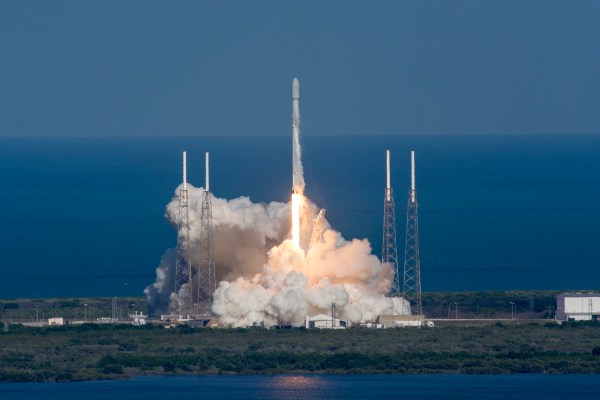It’s been a good week for SpaceX. Earlier this week we learned that the company won a lucrative contract with the National Reconnaissance Office, the tight-lipped government organization that runs America’s reconnaissance satellites. Today, with the launch of Orbital ATK-built communications satellite THAICOM 8 from Kennedy Space Center’s Space Launch Complex 40, SpaceX has for the fourth time landed the Falcon 9’s first stage after a challenging orbital launch. Today’s landing also makes it the third time that the company has landed a rocket on a moving robotic barge “drone ship” at sea.
The orbit that THAICOM 8 was thrown into today is what made the landing especially challenging. The satellite was put into a Geosynchronous Transfer Orbit (GTO), an elliptical orbit that places satellites in a position to get into Geosynchronous Earth Orbit using another smaller rocket motor once the main launcher (in this case, Falcon 9) is expended.
GEO is a circular orbit 22,000 miles above the equator. At GEO, satellites are “fixed” in a point in the sky above a certain part of the world. GEO is commonly used by weather and communications satellites. THAICOM 8 is a commercial communications satellite intended to serve parts of India, Africa and South-East Asia.
As with the previous Falcon 9 launch, today’s launch into GTO required sending the payload into an orbit significantly higher than the more commonly seen ones to Low Earth Orbit. This higher orbit made the arc the rocket needed to take far steeper and more elliptical, making the angle of the descent much deeper and at a much higher velocity.
All of this meant that the margins for error that Falcon’s control system for return had to operate in were that much narrower. More importantly, the higher return velocity really reduced opportunities for the rocket to correct itself in the event of unexpected factors like wind shear and atmospheric fluctuations — small perturbations that at this scale can have significant effects. Moreover, the first stage had to do all of this with less fuel than usual — a consequence of the high orbit.
Today’s vertical landing helps vindicate the cause of reusability that SpaceX is championing. The company aims to rely on this reusability to bring down launch costs and increase space access. There’s also the company’s larger pipe dream of a return trip to Mars, for which landing rockets vertically (so they can be launched back to Earth) is vital.
Still, this dream is only half-fulfilled right now, with today’s first stage joining the other three in their crowded hangar at Cape Canaveral. The dream of reusability can only come true if the stages can be reused again and again. Otherwise, all the effort and design compromises SpaceX put in Falcon 9 for vertical landing will not yield any fruit. SpaceX CEO Elon Musk said on Twitter earlier this month that one of these recovered rockets will be reused in a launch over the next few months. The company did re-fire the Falcon 9 first stage from their first successful recovery on land at Cape Canaveral, but decided not to attempt a reflight, instead planning on placing it in front of the company’s headquarters. Whether or not this is indicative of the fireability of the returned stage is unclear.
The tight margins and high arc of today’s launch mean that the first stage’s landing was close to the maximum landing velocity. This meant that an aluminum honeycomb ‘crush core’ was crumpled and absorbed some of the impact of landing, leading to a slight oscillation in the rocket, Musk explained on Twitter. The ‘crush core’ is part of the retractable landing leg actuator, and was described by Musk as being easily replaceable, though he did add that there was a slight risk of the stage tipping over before the autonomous barge it landed on returns to port.
This post has been updated.
